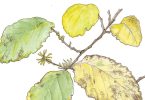By Casey First
The Yellow-bellied Sapsucker (Sphyrapicus varius) is a tree-clinging woodpecker, predominant in much of the eastern and northern US. About the size of the American Robin, the adult Sapsucker measures in at about 9” and has a black-and-white-striped face with an unmistakable bright red crown. It also has a black back with extensive white barring and a distinct black chest shield that sits atop a yellowish-white underbelly. The main distinguishable feature that males have, that the female counterpart lacks, is a red throat. The Yellow-bellied Sapsucker has a stout and pointy bill that is designed perfectly to drill deep into the sides of hardwood trees in search of (you guessed it!) sap.

David Ballard, artist
Sap makes up a very large portion of the diet of these “bark foragers” and the way in which they extract it from trees is meticulous and carefully strategized. Similar to how we extract sap from a tree, these birds drill numerous holes in small lines of neatly organized rows to get to the sweet treat inside. This drilling, unlike the more even and melodic sound patterns from other woodpeckers, is uneven and audibly stutters. They instinctively know the seasonal sap flow and workings of the tree’s inner veins and can adjust their sap well hole patterns and depths to capitalize on this for maximum reward.
Sapsuckers can be spotted perched at the tips of tree branches, readily hunting for flying insects. They will also eat earthworms, spiders, grubs and ants that are on the bark and trapped in sap wells. To supplement their diet, they eat various fruits, high in sugar, from the sap-rich trees in the orchards they inhabit during the winter months. If you are lucky enough to get a Sapsucker to visit your backyard, try offering the same foods that other woodpeckers enjoy, like suet cakes or shelled peanuts.
Here in Western North Carolina, the Yellow-bellied Sapsucker is more often seen at higher elevations (3,500+ feet) during the winter, with sightings more frequent in places like Linville, Blowing Rock and the Nantahala mountains. Their breeding grounds extend from northwestern Canada all the way east to the Atlantic Seaboard and south into parts of the Midwest and northeastern US. In September, they depart these areas for more favorable locales in the southern US, Mexico and much of Central America, returning north in mid-April.
They breed in young aspen and birch forests, excavating cavities in the same live trees they forage for sap. The male drums on trees in their nesting spot to establish territory before breeding begins. In fact, they are so territorial that they’ve been known to drill their bill into metal road signs and chimney flashing to ward off competition for both nesting sites and food. They drill out a new nesting hole each year and it can take up to three weeks for the nest to be built. Mama lays her eggs on top of the wood chips from the excavation process and she will have one brood each season, up to six babies per clutch.
If you don’t see the telltale signs of these Sapsuckers by their sap wells in trees, listen for a scratchy, nasal mewing that is often repeated. For us to continue to marvel at these beautiful migratory woodpeckers and their vital role in our ecosystem (and the tapestry of art they leave on trees!), we need to practice bird-safe habits like keeping cats indoors, protecting windows from bird strikes and skipping out on pesticide use in our greenspaces.
Casey First is owner of North Asheville Wild Birds Unlimited, located at 946 Merrimon Avenue, Suite 120. Monthly bird events are free and open to the public, with no registration required. To learn more, visit NorthAsheville.wbu.com. Artist David Ballard lives in Candler. Find his work on Instagram at d.ballard.art.






